トレーニング&チャット履歴
概要
自ボットの会話ログにアクセスできるのからのトレーニング&チャット履歴"メニューに管理者コンソールです。 のトレーニング&チャット履歴のページでご確認ボットの会話は、応答、言葉、話しいただきました。
訓練には、チャット履歴のページを追加でき新たな応答は、ご挨拶、デフォルト対応します。 示できるお話ボットは、正確に対応します。 ご閲覧および編集することができ、挨拶、デフォルト対応のフレーズや<日本語仮抄訳>欧州連対応します。
時に変更することができますボットの対応、会話の追加や編集、既存の対応をします。 できますキーワードに必要な言葉で、以前の対応と課題へのボットの応答改善のための対応マッチングや会話の文脈です。 できるラベルへの対応に再生し、その他のご質問を参照のラベルです。
お見直しボットの語彙や表現します。 を定義しておくことができま況感は、感情と行動のポーズ、キーワードと同義語です。
また輸入の対応リストの、チャット履歴、AIMLファイルから共有スクリプトライブラリまたはファイルをアップロードコンピュータからです。 きの輸出のダウンロードボットの会話または対応として対応リストの、チャット履歴、またはAIMLファイルです。
ツールバー

| アイコン | 物件名 | 説明 |
|---|---|---|
 |
メニュー | 選択リストからのオプションです。 |
| ホーム | 戻り、チャット履歴の開始ページです。 | |
 |
入 | 入力新しいデフォルト対応します。 |
 |
編集 | 入力の正しい対応をお話しいただきました。 |
 |
検査 | 閲覧、選択した回答はお話しいただきました。 |
 |
選択 | すべて選択の会話に対する対応を、お話しいただきました。 |
 |
間違った | マークの選択回答として無効、または減少その正確性%です。 |
 |
チェック | マークの選択回答として有効回答は増加その正確性%です。 |
 |
旗 | フラグの選択した言葉攻めします。 |
 |
Unflag | Unflagの選択したフレーズとしては攻撃的です。 |
 |
削除 | 削除を選択した応答では、挨拶、デフォルト対応、または会話をします。 |
 |
輸出/ダウンロード | 輸出およびダウンロード、現在表示されているログとしてチャットをログファイル対応リスト、またはAIMLスクリプトです。 |
 |
アップロード | アップロード、輸入チャット履歴、応答リスト、またはAIMLスクリプトです。 |
 |
輸入 | 輸入チャット履歴、応答リスト、またはAIMLスクリプトスクリプトから図書館があります。 |
検索物件
| 特性 | 説明 |
|---|---|
| 検索 | 検索全てのコンバージョン以外の対応は、挨拶、デフォルト対応のフレーズは、単語、または<日本語仮抄訳>欧州連対応します。 |
| 期間 | フィルタの結果による日、週、月、クエリの例を以下に示します |
| フィルター | フィルターの結果のみを含むフレーズを含むフィルタテキストです。 |
| タイプ | フィルターによるチャットやソーシャルメディアメッセージタイプです。 |
| を制限する | フィルタの応答や会話をします。 |
| すべての | に対応す。 |
| 話題 | の課題に対応します。 |
| ラベル | ショーのラベルに対応します。 |
| キーワード | ショーのキーワードに合わせて対応します。 |
| 必要 | の質問に必要な言葉に合わせて対応します。 |
| 感情 | ショーの感情に対応します。 |
| 感情 | ショーの感情に対応します。 |
| 信頼 | ショーの信頼に応答します。 |
| 行動 | ショーの為に対応します。 |
| ポージング | ショーのポーズに対応します。 |
| 次へ | 示す次の質問に対応します。 |
| 前 | ショー前の質問に対応します。 |
| 繰り返し | の対応を繰り返しオプションです。 |
| 条件 | の反応条件コードです。 |
| 考え | の対応を考えます。 |
| コマンド | の応答JSONクライアントのコマンドです。 |
会話
することでボットの会話は、正しい、ボットの応答がなかった場合に答え、また誤対応します。
閲覧の会話
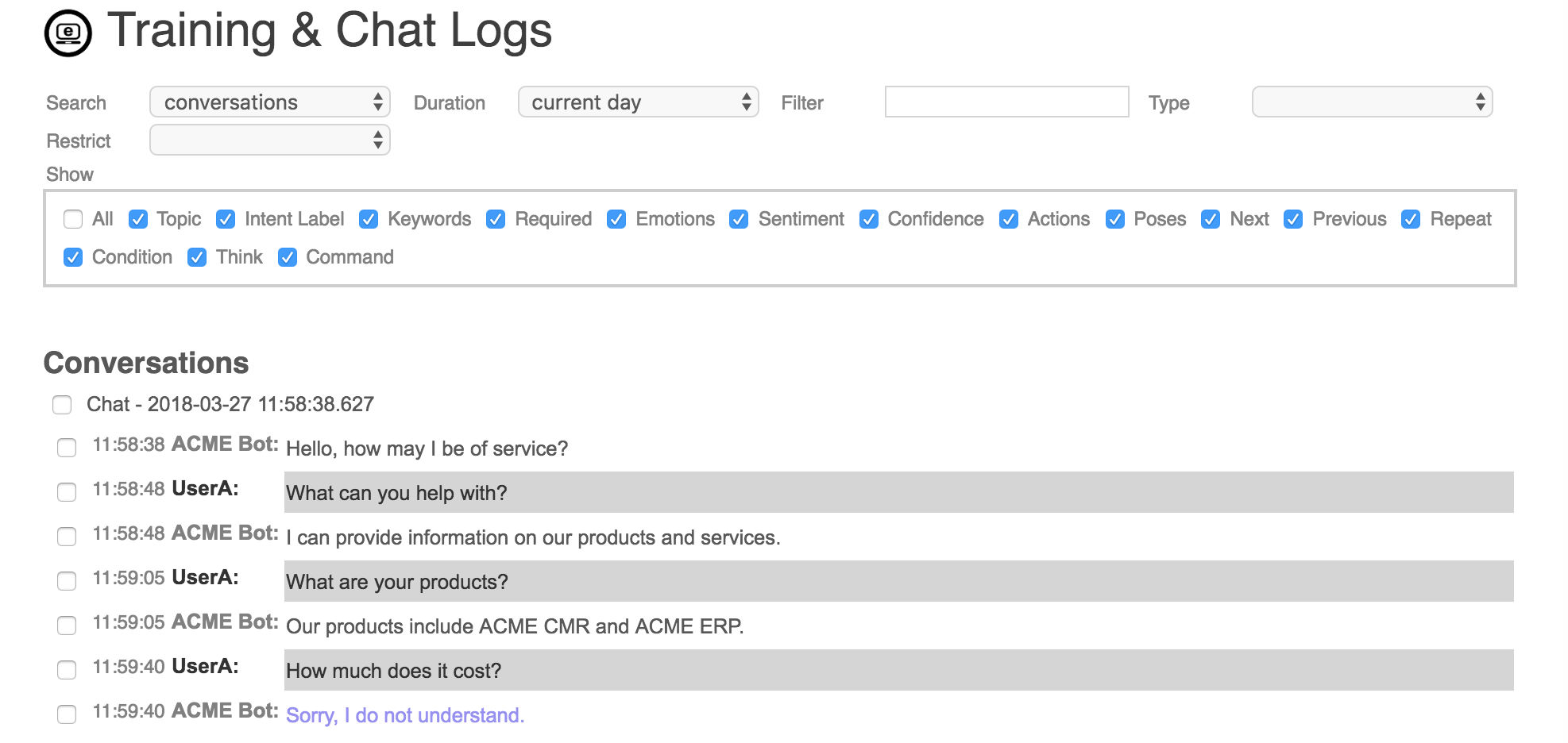
正しい応答

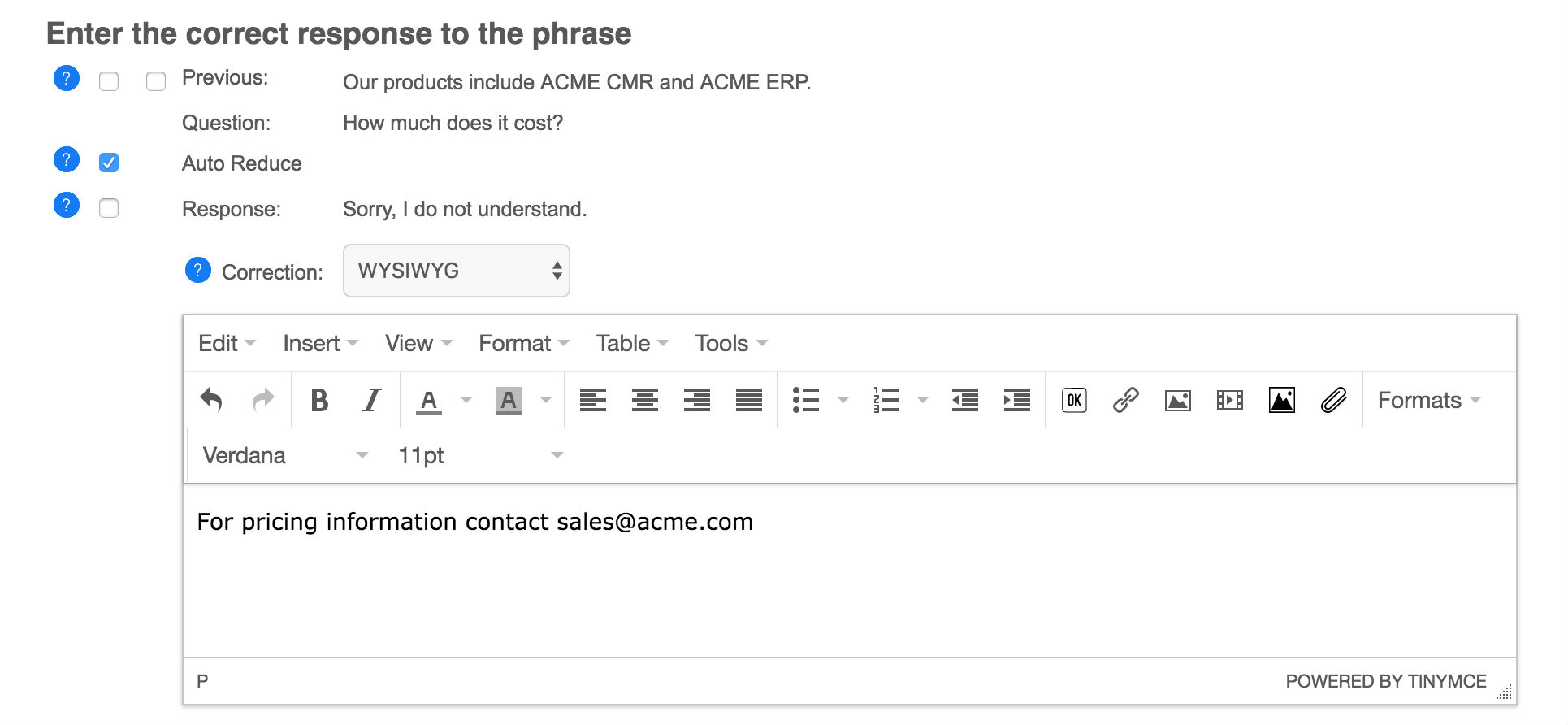
対応
を追加できる新しい反応や編集、既存の対応をします。 回答の設問に対応、各種のメタデータに対応します。
すべてのボットの訓練の対応検索対応のためのすべての期間です。 このリストのすべてのボット対応いほうから順に順序付けられていを追加しました。 応答がないだけに使用することに正確な質問になった、もしくはこれに類似する質問です。 がボットとの出会いの質問で分からない答えでエー-エス-エスではグローバルマッチング問いることを知り尽くしへの対応、利用に応じます。 場合は、ボットを知らない他の同様の問題は、その利用は、デフォルト対応します。
対応ブラウザーでの展開への対応、または編集して、削除して、invalidate、validate、フラグ、既存の対応をします。
対応のエディターの入力の質疑応答およびオプションの応答特性とメタデータを指すものとします。 選択できますの編集には対応を用い豊富な"WYSIWYG"の項目で検索条件を絞り込んだエディタ、または平文テキストエディタです。 対応HTMLでが含まれていますのHTMLタグなどの<b>大胆なので、<a<url>"target="_blank">リンクには、<img>画像、および<ボタン>ボタンを押します。

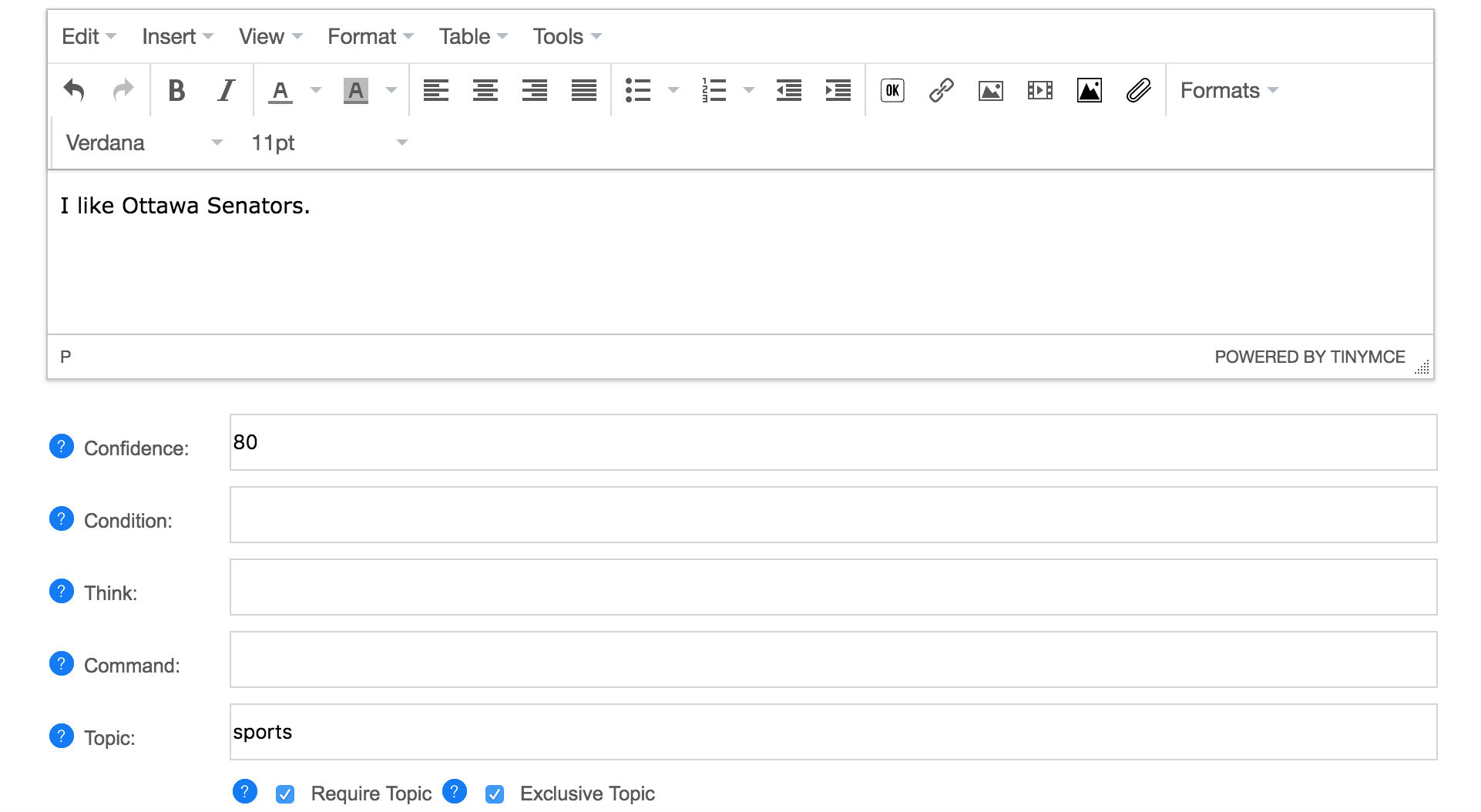


応答特性
| 名称 | 説明 |
|---|---|
| 質問 | 編集のご希望があれば、利用できる*ワイルドカードへのパターンです。 |
| 感情 | することができ、感情、言葉です。 |
| 新規対応 | 入力新しい応答のためのフレーズです。 |
| 条件 | 任意で来ることができるアクセスの条件で自己のコードを行い、評価しなければならなtrueに対応する利用です。 |
| 考え | 任意を与えることができます'こしているコードを自己を評価される時に応答が使用される。 |
| コマンド | 任意を与えることができますJSONコマンド(コード)を評価し、クライアントに返される支援にゲームや仮想案内もあります。 |
| 話題 | 任意を与えることができます話題分類に対応します。 |
| 意ラベル | 任意を与えることができますラベルの再利用に対応しています。 |
| キーワード | 任意で来ることができるアクセスのキーワードからの質問への影響がありますので、ま対応致します。 |
| 必要 | 任意で来ることができるアクセスに必要な単語からの質問に対して必要となる対応を致します。 |
| 感情 | することができ、感情に対応します。 |
| 行動 | できますアクションに対応します。 |
| ポージング | することができるポーズに対応します。 |
| スピーカー | 任意で来ることができるアクセスへの対応る場合は、使用電流応答はすでに使用されている。 |
| な繰り返し | 必要に応答またはフレーズのみ使用されます。 |
| 次へ | 任意を与えることができます次の応答への対応のコンテキストです。 |
| 前 | 任意を与えることができます前回の対応への対応のコンテキストです。 |
| 要前 | 必要に応答にのみ使用する場合は前回の対戦は前回の対応です。 |
| 保存 | 保存の訂正のお話しいただきました。 |
Question
に対応できるであろうと言葉が自動的に合わせた同様の質問とすることもできます。 パターンに合わせたかの順に単語をパターンは、ワイルドカード文字などの*を含めることもできます。 通常で使うようになりましたボットを決めた場合に質問を一致させる必要があることもでき追加のキーワードに必要な言葉を改善が問題とは一致します。 入力パターンを使えばワイルドカードなどの質問は、入力パターンは下記のようになっています。
Pattern("What is *")
Response
に対応できるフレーズに、を含むことができHTMLや豊富なコンテンツ含む画像、映像、ボタン、または対応できるテンプレートを作成します。 テンプレートは対応することができ、自。 任意のコード内で{}テンプレートが実行され、結果が印刷に対応します。 入力テンプレートだけが含ま{}に対応や入力したテンプレートは次のように利用しないのWYSIWYGエディタのためのtempatesます。
Template("Today is {Date.date()}.")
Keywords
Keywords are important words in the question that should influence when the response is used.
// Keywords are used to allow this response to be used for any questions on hockey or spinach. question: do you like hockey response: Hockey is my favorite sport. keywords: hockey question: what do you love response: I love hockey! keywords: love luv like adore question: do you like field hockey response: I only play ice hockey. keywords: "field hockey" question: i love spinach response: Spinach is is my favorite food. keywords: spinach
A keyword will be used by the bot to select the best response. Keywords let some words count for more than other words. In the example, the bot knows two responses, how will it respond to the phrase "I love hockey"? Without the keywords the bot would probably match this question with "I love spinach", but since hockey is a keyword, it will instead match it with "Do you like hockey?".
If the response has no defined required words, then the keywords will also be required for the response match. So "I love hockey" would not be matched with "I love spinach." because it is missing the keyword.
If you keywords has many similar words. You can list them all as keywords to match any of the words. You could also define these words a synonyms, which may be a better option.
You can also use compound words are keywords. A compound keyword must have all the words in the order to be used. For a compound keyword just wrap the words in "quotes".
Be careful using too many keywords. If every word is a keyword, then their value is diminished. Never make common words like "the", "a", "he", "what" keywords, if you require one of these words for a match use a required word instead.
You can also review all of your bot's keywords by searching for 'words' and restrict to 'keywords'. This lets you remove a word from being a keyword if you added it by mistake.
Required
A required word is a word that is required to be in the question for a specific response.
// This example requires the words 'like' and 'hockey'.
question: do you like hockey
response: Yes, I like hockey.
required: like hockey
// This example requires the compound word 'ice hockey'.
question: do you like ice hockey
response: Yes, I like ice hockey.
required: "ice hockey"
// This example requires one of the words 'like' or 'love', and 'hockey'.
question: do you like ice hockey
response: Yes, I like ice hockey.
required: (like love) hockey
// This example requires a pattern.
question: are you okay
response: Yes, I am okay.
required: Pattern("^ are you (ok okay)")
A required word can be used to ensure the bot does not choose a response if the required word is missing from the question. For example the question "Do you play hockey?" would normally be matched to this response, but because it is missing the required word "like", it will not be considered as a match.
All of the required words must be contained in the question in order for the response to be used. Required words also supports lists, compound words, and patterns. To require one of a set of words a list can be used using brackets i.e. (like love). To require a compound word quotes are used i.e. "hello world". To require a pattern enter the pattern i.e. Pattern("what is *").
Previous
A previous responses is the bot's preceding response. Previous responses can be used to give a response a context.
// This example uses previous to give different answers to 'yes' depending on the context. question: yes response: Great, wanna go out sometime? require previous: Are you single? question: yes response: I am please to hear that. require previous: Are you happy?
The question "Yes" has multiple responses. The bot can use the previous response to choose the best response. You can also invalidate a previous response to ensure the bot does not use a response if the previous response was preceding.
A previous response can either be 'required' or optional. If required, the response will never be used unless one of the previous response matches. If optional (default) the response is given precedence if the previous response matches, but can still be used if the previous does not match.
Topic
A topic is the general topic category for the response. For example a response on a hockey related question would belong to the "hockey" topic. You can use topics to categories your responses and give the bot additional context. If the bot has multiple responses to a question, it will use the one that matches the current topic.
Topics can be either optional or required. The response topic is optional by default, it you click on 'Require Topic', then the response will only be used if that topic is active in the conversation. If optional the topic will be set as active for the conversation, until a new topic is set.
Topics can also be defined as exclusive. An exclusive topic defines an isolated conversational space. For a normal topic that is not exclusive the bot can still use responses that do not have the same topic, but responses with the active topic will be given precedence over responses without a topic. For exclusive topics only response that have the same topic as the active topic will be used. No other responses will be used (other than possibly the default response if there is no topic default).
Topics can also be set on greetings to start the conversation with a topic. Topics can be set on default responses to provide a different response when that topic is active.
// Categorizes the product response. question: what are your products response: Our products include ACME CRM and ACME ERP. topic: products // Use an exclusive topic to define a joke conversational dialog. question: joke response: Knock knock. exclusive topic: joke question who is there response: Boo. require topic: joke question: boo who response: Don't cry. lol require topic: joke think: conversation.topic = null; default: Say 'Who is there?' require topic: joke default: Say 'Boo who?' require topic: joke previous: boo
Intent Labels
A response can be given an intent label to let you reuse the same response in other questions. You can also use labels in a response's previous.
// Use a label to reuse the common products response. question: products response: Our products include ACME CRM and ACME ERP. label: #products question: what are your products response: #products question: what software do you sell response: #products question: are they good response: Our products are the best in the world. previous: #products
On Repeats
If the user asks the same question, or similar questions multiple times, you may want your bot to give a different response the second time. On repeat lets you set one or many responses to use the second time that response is triggered in the same conversation. You can also set 'No Repeat' to never repeat the response in the same conversation.
// Offer to escalate the issue if the user repeatedly asks for help. question: help response: How can I help you? on repeat: What is the issue that you are having? on repeat: Would you like me to have a support staff contact you? question: goodbye response: Before you go, would you like to take a survey? no repeat: question: goodbye response: Goodbye.
Conditions
Conditions let you enter Self code that must evaluate to true for the response to be used. This is an advanced properties as it requires you understand Self (a dialect of JavaScript), but can be used to do very powerful things.
// Response to goodbye differently based on the time of day. question: goodbye response: Goodnight. condition: Date.get(#hour, Date.time()) > 18 question: goodbye response: Goodbye.
Think
Think let you enter Self code that is executed when the response is used. This is an advanced properties as it requires you understand Self (a dialect of JavaScript), but can be used to do very powerful things.
// Track the user's name.
pattern: my name is *
template: Pleased to meet you {star}.
think: speaker.name = star;
question: what is my name
template: Your name is {speaker.name}.
question: can we change the subject
response: Sure, what would you like to talk about?
think: conversation.topic = null;
Confidence
You can enter multiple responses for the same question. The bot will use the response that it is the most confident in for the current conversational context. By default a response is given a confidence level of 90%, but you can customize the value. Note that in a group discussion such as when the bot is added to a chatroom, or on Twitter, the bot will only use responses that have >=90% confidence.
Sentiment
You can associate a user question or phrase, or individual words with sentiment (good vs bad). Sentiment can be used to track how the user is feeling about the current conversation. The sentiment statistic is tracked by your bot daily and can be graphed from its Analytics page.
question: thank you response: You are most welcome. keywords: thank sentiment: good question: you suck response: Sorry, I am doing my best. Would you like me have someone contact you via email? keywords: suck sentiment: bad word: suck sentiment: bad word: great sentiment: great
次に、会話の流れ
次の質問に回答できる対応のフォローまでの質問と会話の流れです。 会話の流れをクリックして、親会社の対応の歯車メニューをクリックし、グリーンプラス追加、入れ子に応じます。 でこれを繰り返し数を定義する完全な会話です。
A responeの次なる問題を定義します孤立した会話スペース。 ボットでのみお選び次の応答に対応します。 を定義するデフォルト対応の#デフォルトとしての問題をもたらしていました。 場合は、ボットネットワーユーザーの質問と来るかというと、検索の対応が親会社、それ以外の利用、ボットのデフォルト対応します。
次は前のものとは異なり前は分離されに対応します。 の文脈となることが期待される応答は、ボットのない使用に対応以外のコンテキストは次対応します。 ここで定義すら単離および入れ子の会話です。
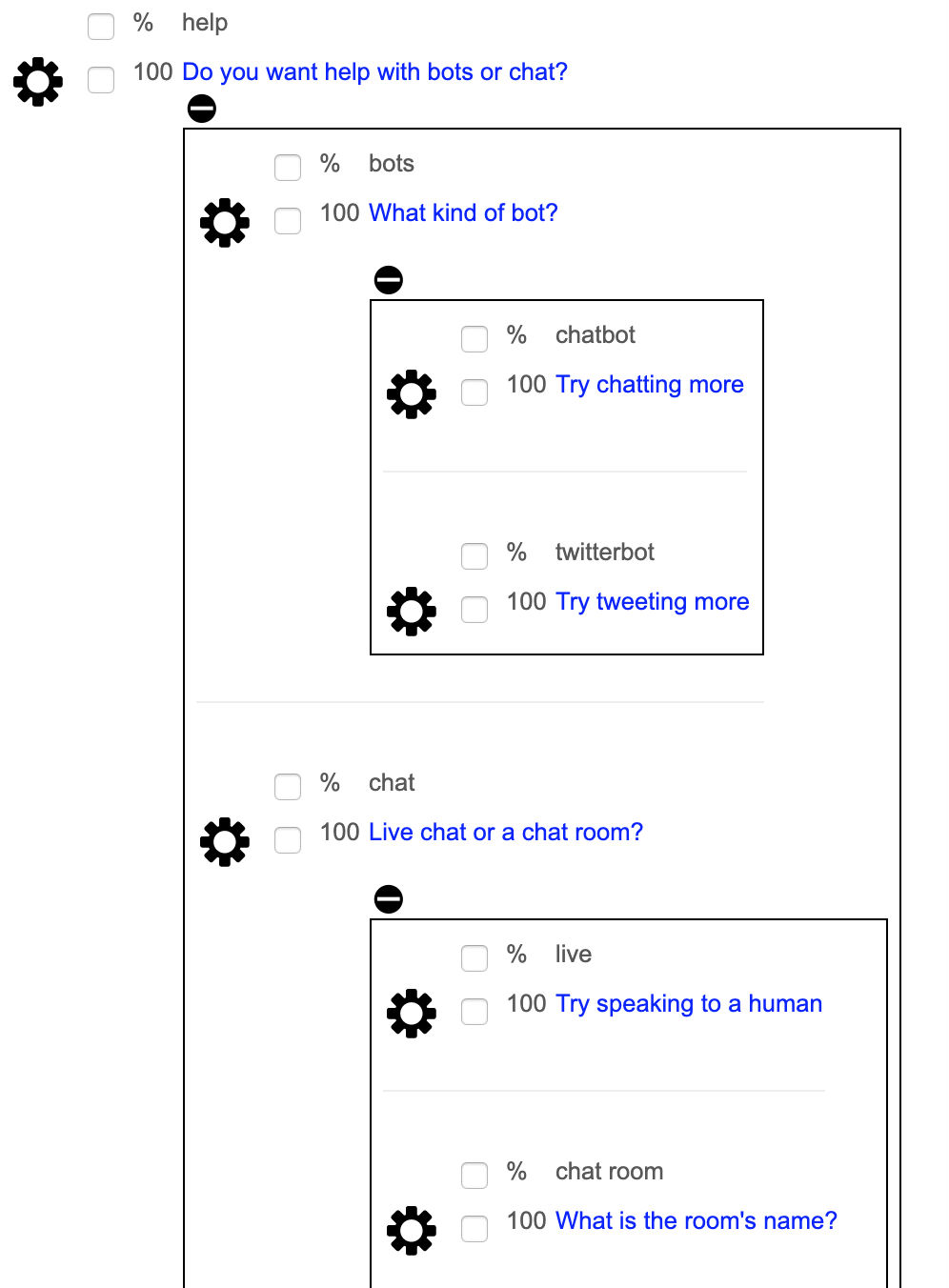
ご挨拶
挨拶では、ボットの初期対応の新しい会話です。 を追加できる新しい挨拶、または編集、既存の挨拶です。 挨拶を含めた各種のメタデータのご挨拶です。
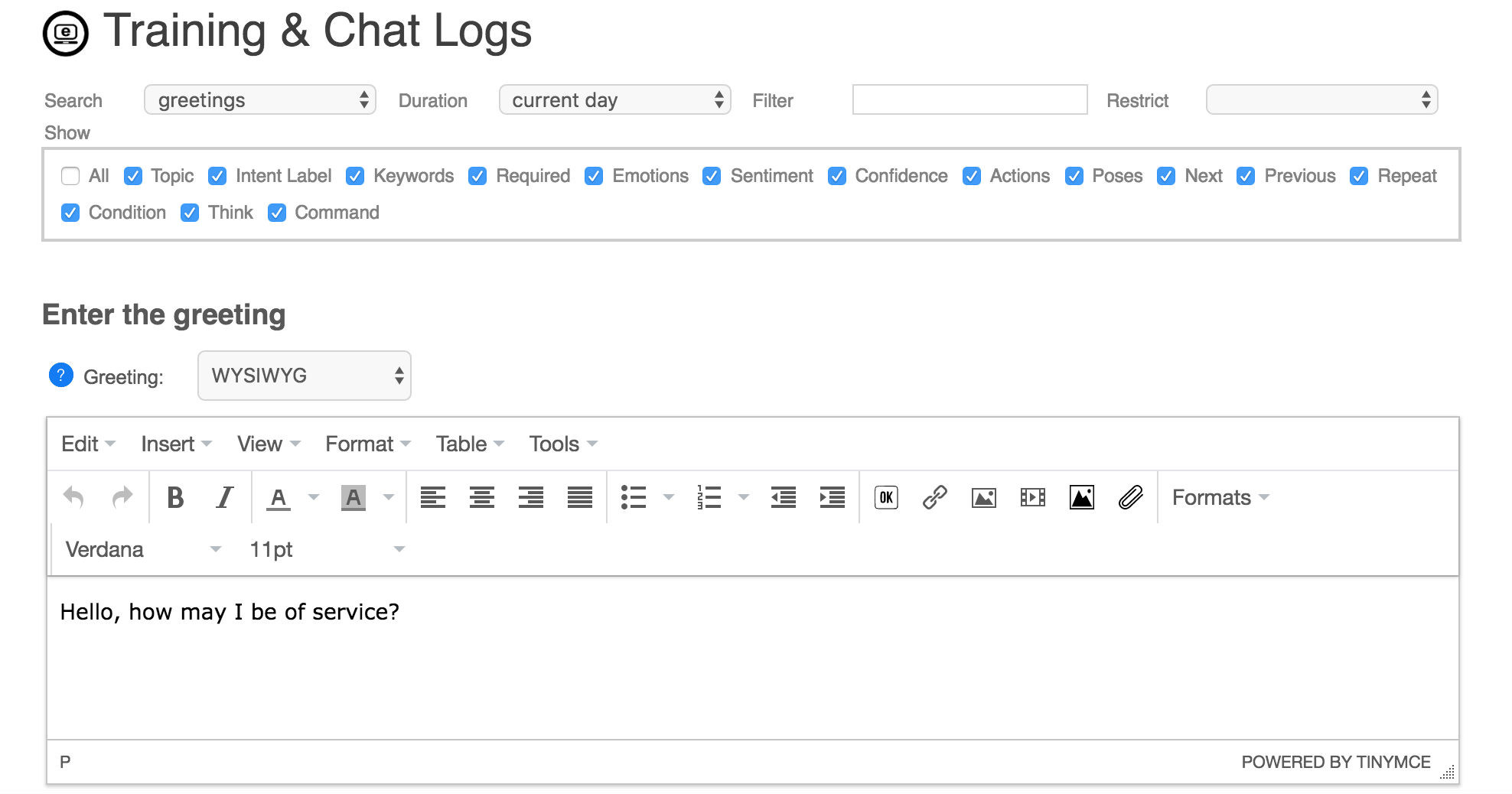

ご挨拶性
| 名称 | 説明 |
|---|---|
| ご挨拶 | 編集のご挨拶です。 |
| 条件 | 任意で来ることができるアクセスの条件で自己のコードを行い、評価しなければならなtrueに対応する利用です。 |
| 考え | 任意を与えることができます'こしているコードを自己を評価される時に応答が使用される。 |
| コマンド | 任意を与えることができますJSONコマンド(コード)を評価し、クライアントに返される支援にゲームや仮想案内もあります。 |
| 話題 | 任意を与えることができます話題分類に対応します。 |
| 専用課題 | を任意に設定できる専用の話題に話でのみの対応としてこのテーマを使用します。 |
| 意ラベル | オプショき意ラベルの再利用に対応しています。 |
| 感情 | することができ、感情のご挨拶です。 |
| 行動 | できますアクションに挨拶します。 |
| ポージング | することができるポーズをと挨拶します。 |
| 次へ | 任意を与えることができます次の挨拶に対応コンテキストです。 |
| 保存 | 保存の訂正のお話しいただきました。 |
デフォルト対応
場合は、ボットなものは見出せないマッチングついて調査しなければならずユーザの入力で、デフォルト対応します。 を追加できる新しいデフォルト対応、または編集、既存のdefalult対応します。 デフォルト対応を含めた各種のメタデータに対応します。

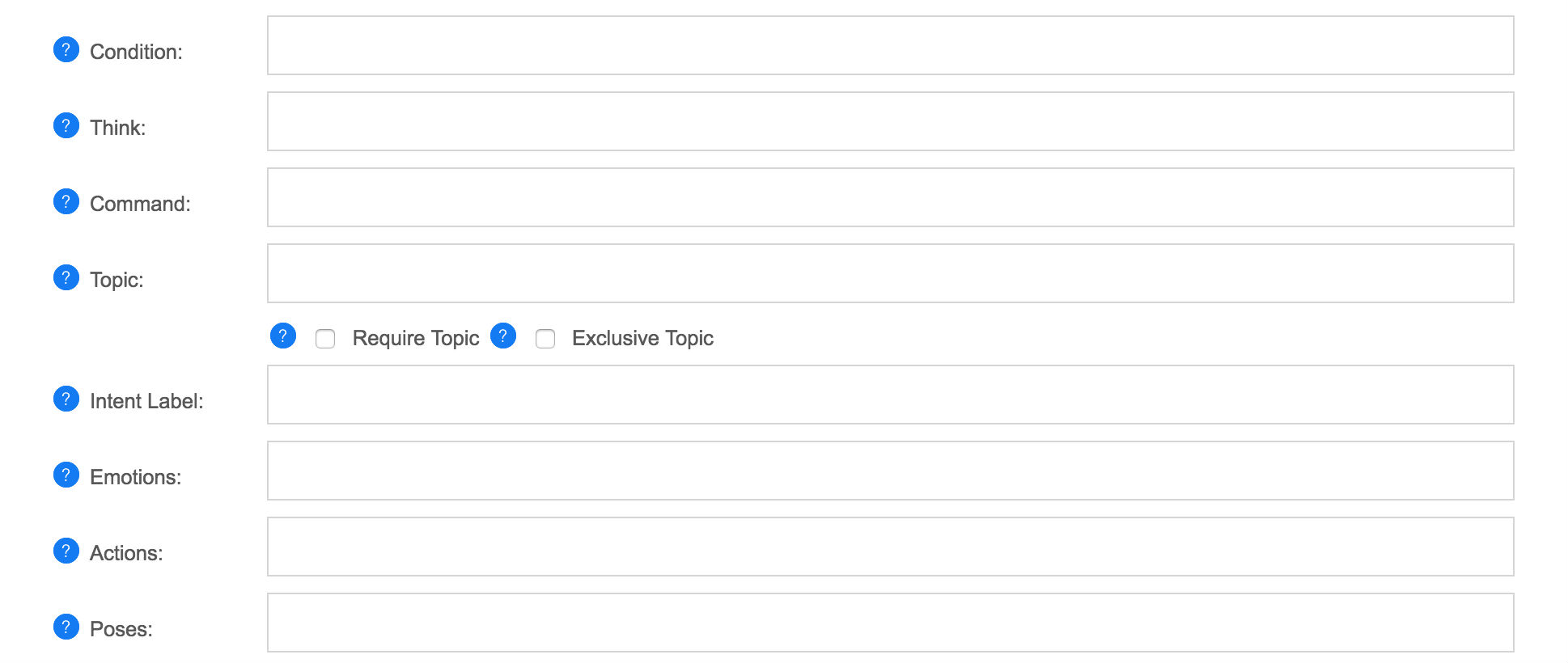

デフォルトの応答特性
| 名称 | 説明 |
|---|---|
| デフォルト対応 | 編集デフォルトのレスポンスです。 |
| 感情 | することができ、感情のデフォルト対応します。 |
| 行動 | できますアクションのデフォルト対応します。 |
| ポージング | することができるポーズでのデフォルト対応します。 |
| 条件 | 任意で来ることができるアクセスの条件で自己のコードを行い、評価しなければならなtrueに対応する利用です。 |
| 考え | 任意を与えることができます'こしているコードを自己を評価される時に応答が使用される。 |
| コマンド | 任意を与えることができますJSONコマンド(コード)を評価し、クライアントに返される支援にゲームや仮想案内もあります。 |
| 話題 | 任意を与えることができます話題分類に対応します。 |
| ラベル | 任意を与えることができますラベルの再利用に対応しています。 |
| スピーカー | 任意で来ることができるアクセスへの対応る場合は、使用電流応答はすでに使用されている。 |
| な繰り返し | 必要に応答またはフレーズのみ使用されます。 |
| 前 | 任意を与えることができます前回の対応への対応のコンテキストです。 |
| 要前 | 必要に応答にのみ使用する場合は前回の対戦は前回の対応です。 |
| 保存 | 保存の訂正のお話しいただきました。 |
フレーズ
を追加できる新しいフレーズに、編集、既存のフレーズです。 言葉は文章ではなる場合があります。 この言葉は編集できるのは"感情-感情-行動し、ポージングは、対応言葉です。
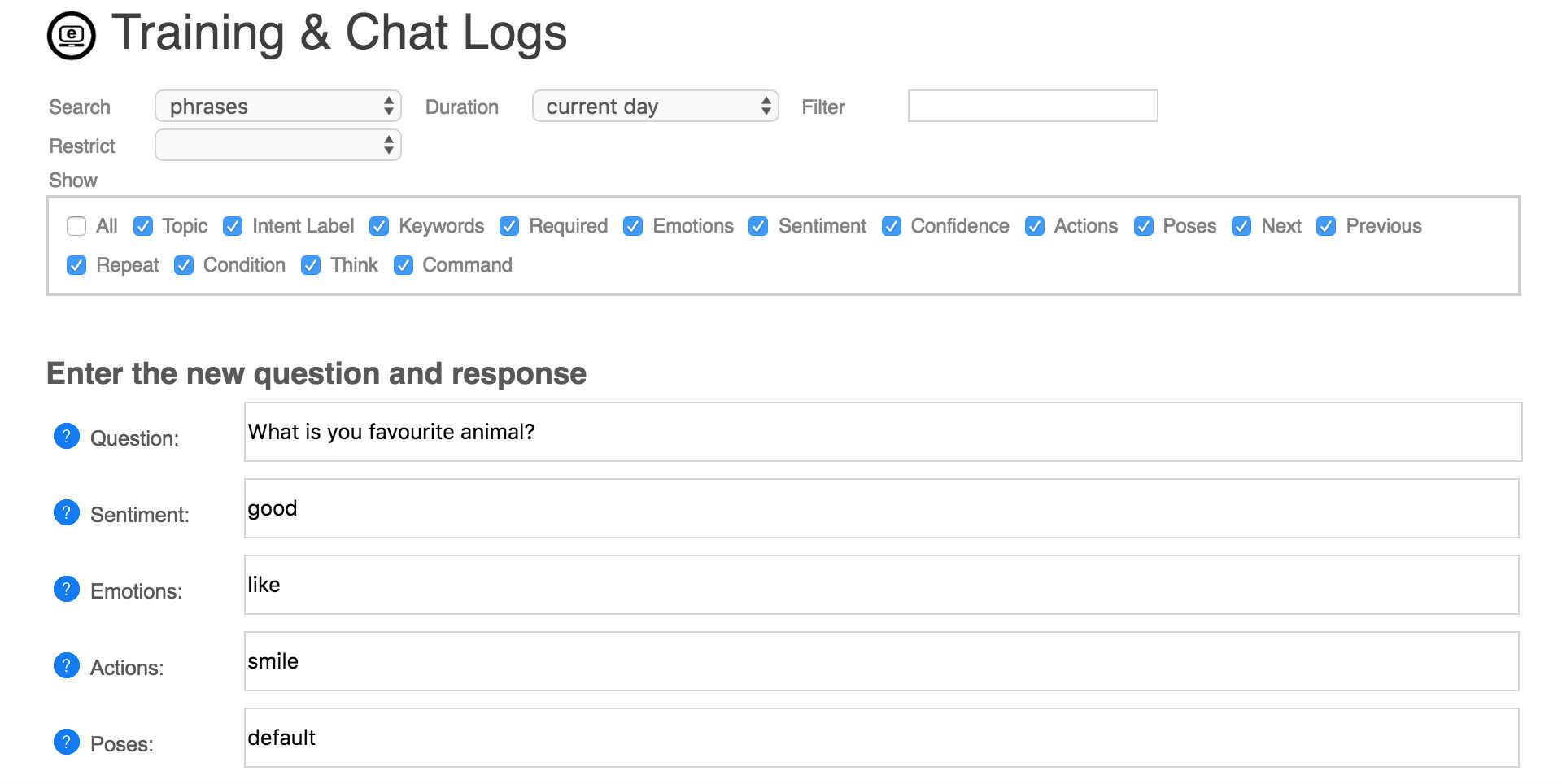
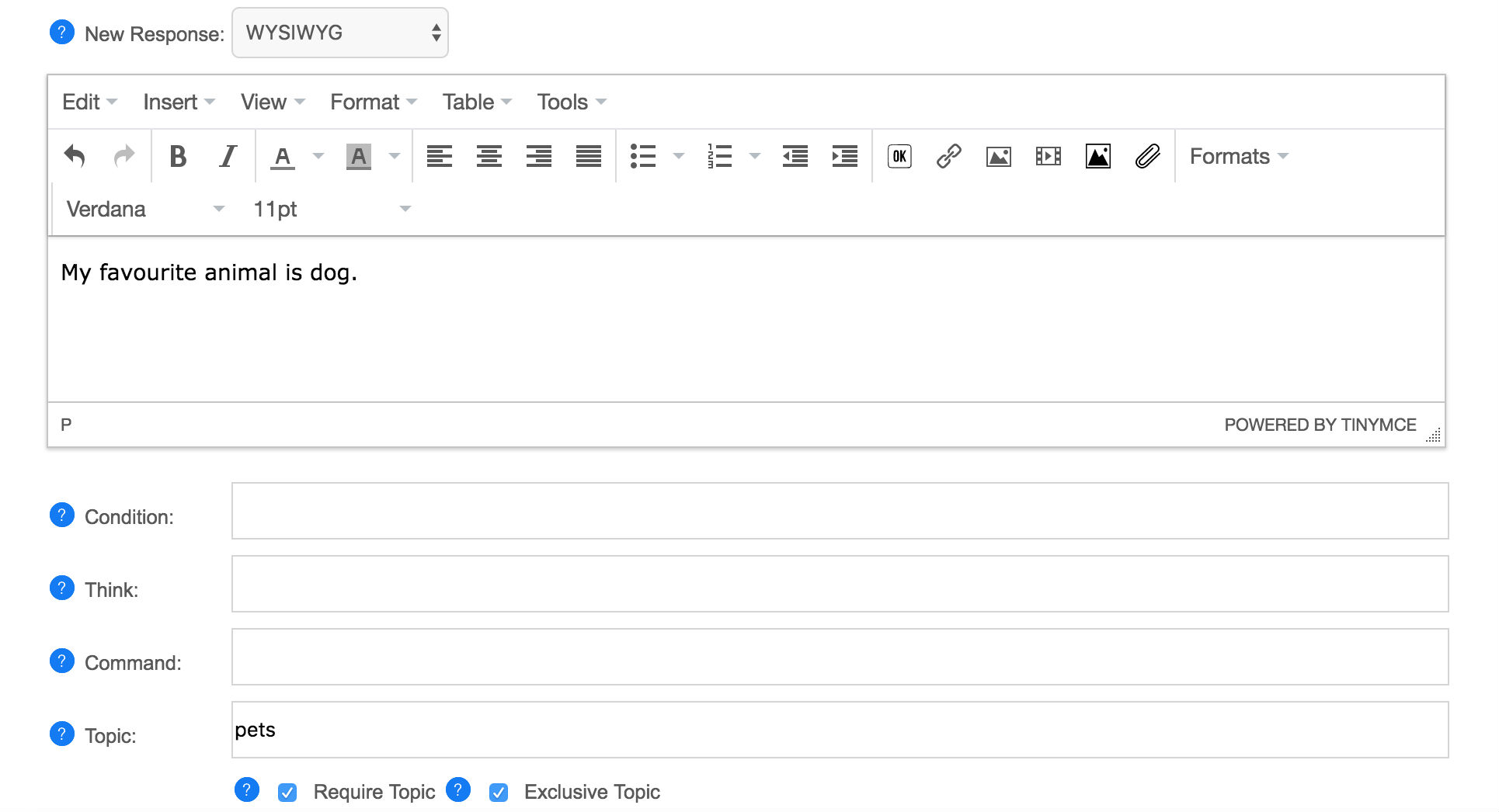
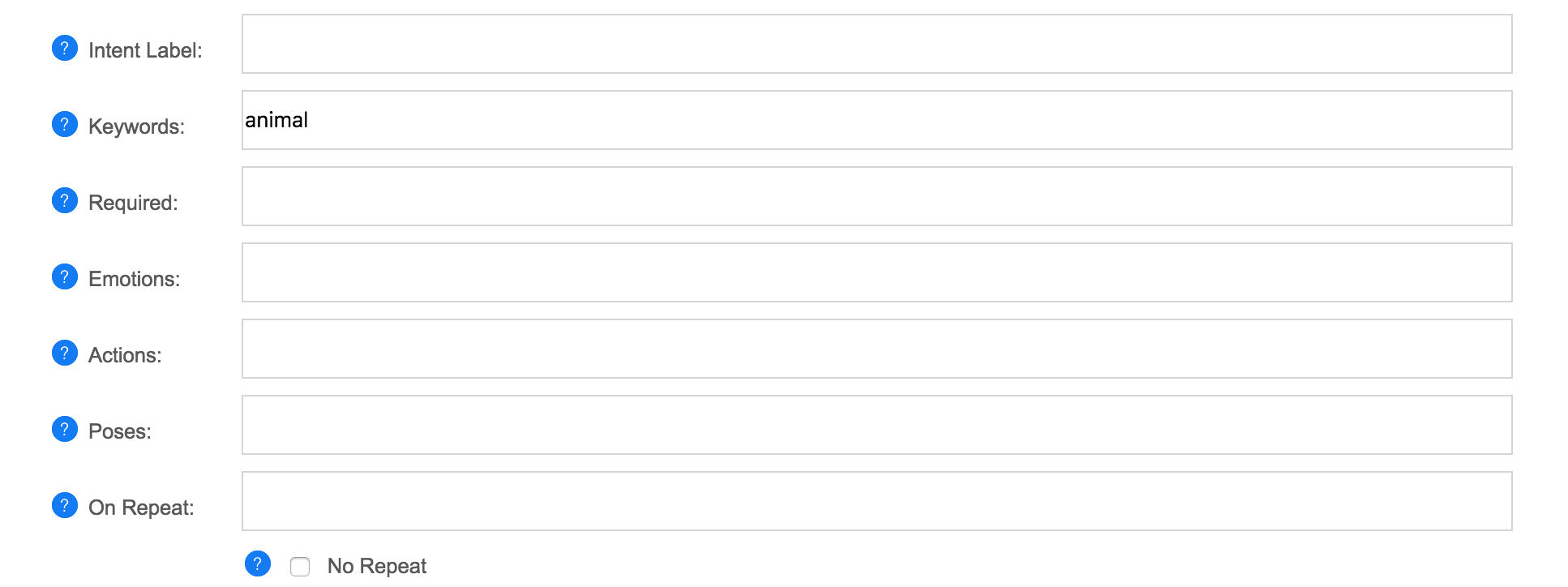

フレーズ物件
| 名称 | 説明 |
|---|---|
| 質問 | 編集のご希望があれば、利用できる*ワイルドカードへのパターンです。 |
| 感情 | することができ、感情、言葉です。 |
| 感情 | することができ、感情、言葉です。 |
| 行動 | できますアクションの言葉です。 |
| ポージング | することができ、ポーズのフレーズです。 |
| 新規対応 | 入力新しい応答のためのフレーズです。 |
| 条件 | 任意で来ることができるアクセスの条件で自己のコードを行い、評価しなければならなtrueに対応する利用です。 |
| 考え | 任意を与えることができます'こしているコードを自己を評価される時に応答が使用される。 |
| コマンド | 任意を与えることができますJSONコマンド(コード)を評価し、クライアントに返される支援にゲームや仮想案内もあります。 |
| 話題 | 任意を与えることができます話題分類に対応します。 |
| 意ラベル | 任意を与えることができますラベルの再利用に対応しています。 |
| キーワード | 任意で来ることができるアクセスのキーワードからの質問への影響がありますので、ま対応致します。 |
| 必要 | 任意で来ることができるアクセスに必要な単語からの質問に対して必要となる対応を致します。 |
| 感情 | することができ、感情に対応します。 |
| 行動 | できますアクションに対応します。 |
| ポージング | することができるポーズに対応します。 |
| スピーカー | 任意で来ることができるアクセスへの対応る場合は、使用電流応答はすでに使用されている。 |
| な繰り返し | 必要に応答またはフレーズのみ使用されます。 |
| 次へ | 任意を与えることができます次の応答への対応のコンテキストです。 |
| 前 | 任意を与えることができます前回の対応への対応のコンテキストです。 |
| 要前 | 必要に応答にのみ使用する場合は前回の対戦は前回の対応です。 |
| 保存 | 保存の訂正のお話しいただきました。 |
言葉
を追加できる新しい単語や編集、既存の言葉です。 単語を含むマインドの感情や同義語です。 単語ることもできるキーワードは、トピックや専用です。
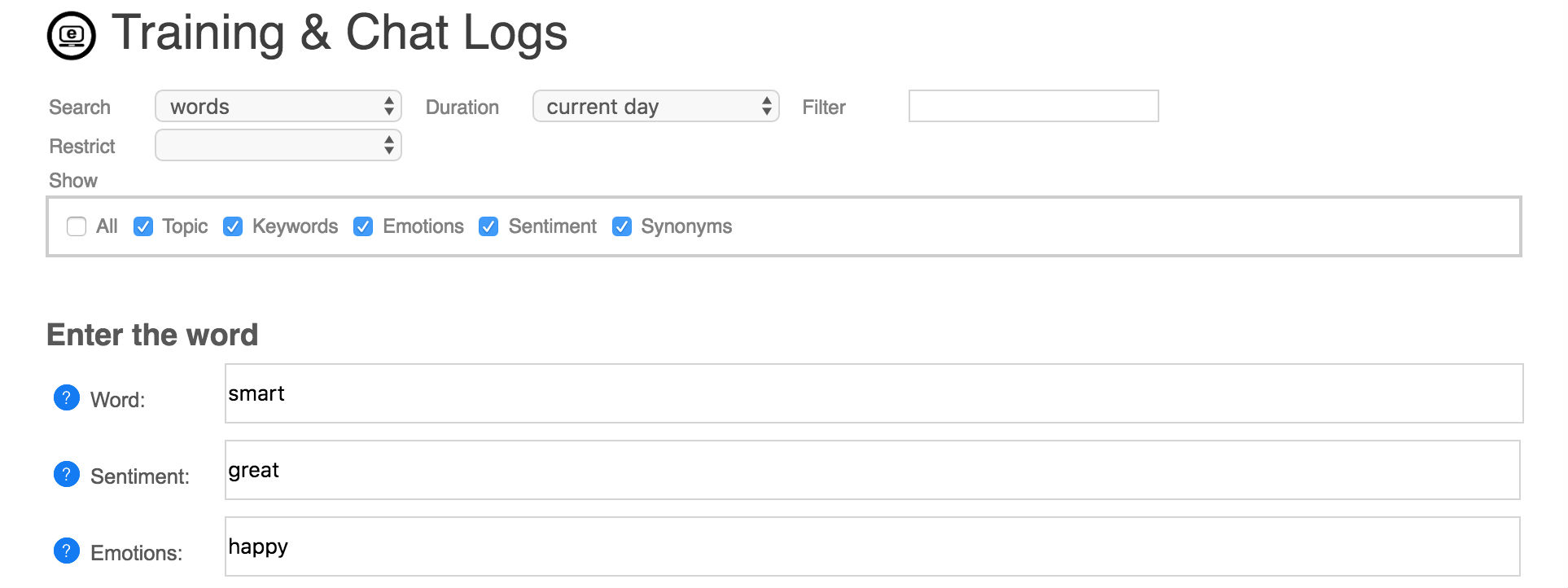

単語の性質
| 名称 | 説明 |
|---|---|
| 言葉 | を編集します。 |
| 感情 | 任意することができ、感情、言葉です。 |
| 感情 | 任意することができ、感情、言葉です。 |
| キーワード | を定義する言葉をキーワードです。 |
| 同義語 | 任意を与えることができますリストの同義語の単語、同様の言葉からのトリガに同じ対応します。 |
| 話題 | を定義する言葉を話題です。 |
| 専用課題 | を定義する言葉を見ます。 |
| 保存 | 保存を訂正します。 |





